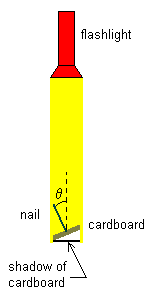Shine a flashlight onto a card. Notice how the size of the shadow on your desk depends on the oreientation of the card with respect to the beam of light. Come up with a formula that describes how much light was being blocked by the card.
Each group needs: flashlight, small piece of cardboard, nail (2-3" with large head), protractor, ruler, meterstick
- How do you define the
orientation of a plane surface? Discuss with your group.
- Make a drawing that shows
how you could use a nail and a piece of cardboard to represent a unit of area.
What angle should be used to define the orientation of the surface?
- State which orientation
of the nail and the beam of light represents 0°. Which represents 180°?
- Hold the flashlight approximately
one meter above the table and shine light from the flashlight down onto the
cardboard held near the table.
- Vary the angle of the
cardboard and measure the area of the shadow on the table. Do this for ten
angles between 0° and 180°. (Is there an easy way to measure the angle?) Which
variables must you hold constant while taking these measurements?
- Sketch a graph of the
area of the shadow versus angle. The shadow indicates the amount of light
flux, or the light intercepted by the cardboard. What mathematical model represents your
results?
